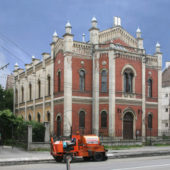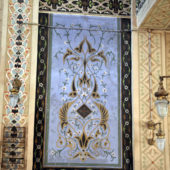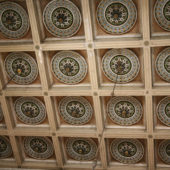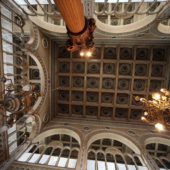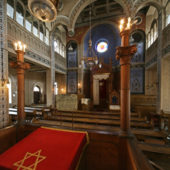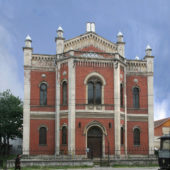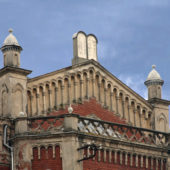An Italianesque, neo-classic exterior adorns this synagogue’s beautifully renovated interior.
The Synagogue in Sibiu is an unusually designed Orthodox Synagogue with more than a century of fascinating history. The congregants have been comprised of largely Ashkenazi Jews.
Sibiu is in the Transylvania region of Romania (which until after World War I was governed by Hungary). The very first Jews arrived in Sibiu with the Roman legions in 101 AD. Since that time, the first documentation of Jews having trading or other dealings with Sibiu is in the beginning of the 15th century, after Spain’s expulsion of Jews in 1492. Records show Jews began settling there after Hungary’s restrictions regarding Jewish residency were lifted in 1848, fleeing from Cossack uprisings in Poland and the Ukraine. In 1850 there were 478 Jews living in Sibiu, which comprised 3% of the total population. In 1860 a permanent minyan (minimum of 10 Jewish men required to conduct a religious service) and in 1876 an organization of institutions was established. In 1868 the community determined itself to be Orthodox and in 1878 the first synagogue in Sibiu was built. In 1890 a second, larger synagogue was completed, at which time the Jewish community totaled 1307 members. By 1920, Jewish population has increased to 1310.
Armin Horowitz was the Orthodox Rabbi of the Synagogue from 1890. In 1923 a Sephardic community was established. Immediately after the first Zionist Congress, Zionist activity in Sibiu commenced and quickly grew between the two World Wars. In 1919 a Jewish school was established, along with a community-run Hebrew nursery school. In 1940 Sibiu had three Synagogues, three rabbis, two cemeteries, and two ritual baths, managed by Sephardic and Orthodox communities. In 1941 the Jewish community’s population was 1361 and by 1947 had risen to 2020. Most of the community spoke German and only a minority learned Hungarian and Romanian. During WWII the synagogue and school were abolished, communal property was seized and the community was persecuted. Early in the war Sibiu was a mobilization center for the region for forced labor among Jews and from August 23, 1944, as a refugee center.
The Great Synagogue was built by architect Szalay Ferenc in 1899, with funds collected from the community. Its brick and concrete facade features a refined neo-classic/Renaissance appearance and the faintly ogive-shaped molded profiles decorating the lintels of the twin windows add a gothic aspect. The concrete is a beautiful contrast to the brickwork and is intricately wrought in the molding along the top of the building. Two tablets with The Ten Commandments inscribed in Hebrew sit on the pinnacle of the roof. Inside, the synagogue has a basilica aspect with three naves mounted by lofts. The spacious room is painted in taupe, with intricately carved molding throughout, and central ceiling semicircular arches with repeated Moorish motifs. Windows flank the sides of the prayer room, upstairs and downstairs. The same Moorish-shaped arches are repeated in the multiple colonnades of the upstairs galleries’ balustrades which run across three walls. The ceiling is coffered with carved designed inlaid and hand-painted, and there are hand-painted decorations throughout the prayer-room which tie in with the ceiling. The Aron Kodesh is on the elaborately decorated East wall. The wall is largely decorated in blue, and the Aron Kodesh itself is situated in a recess in the wall, with a stained glass window above it. The Aron Kodesh is encased in beautifully carved wood, and an elegant ivory curtain embroidered and tasseled in gold is pulled aside to reveal a heavy wine colored velvet torah curtain, also embroidered. Beautiful painted decorations are on the walls flanking either side of the Aron Kodesh. The bimah is featured in front of the Aron Kodesh, surrounded by four beautifully carved wood columns with composite capitals, upon which candelabras sit. Wood pews fill the sanctuary. The Great Synagogue was declared a historical monument by the Romanian Academy.
In 1970 approximately 125 Jews were living in Sibiu. Today, there are 32 Jews in the community. Friday night and holiday services have continued to take place in a small prayer house in the back of the Great Synagogue. In 1986 the Synagogue was vandalized, with many valuable items such as silver candelabras stolen and other things damaged; however, the Torah scrolls were not taken. The main synagogue has been closed since 1999. Most of the congregants are elderly, with only one person under twenty years of age. All of the congregants speak Hebrew and only three of them speak Yiddish. There is a lot of intermarriage in the community.
The Great Synagogue at Sibiu has had a proud history. It has been through times of great tragedy and risen from them. Sadly, the Jewish community in Sibiu in recently years has significantly dwindled. Sibiu Synagogue has been a testimony to the faith, traditions and culture of the Jewish people and although its community is now smaller, it continues to do so.

